to the index page
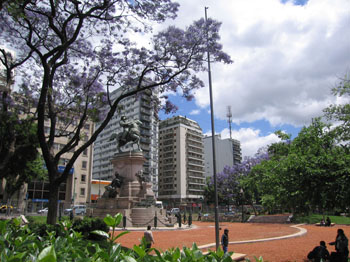
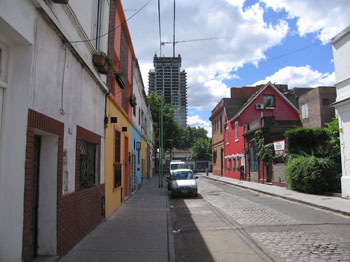
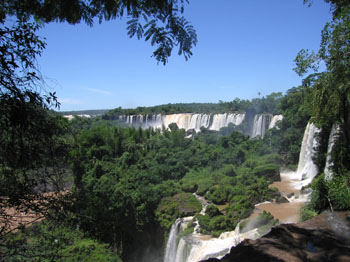

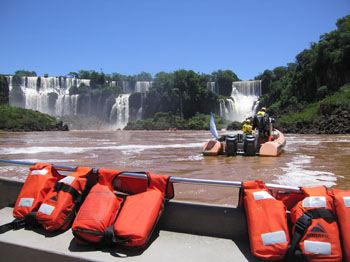
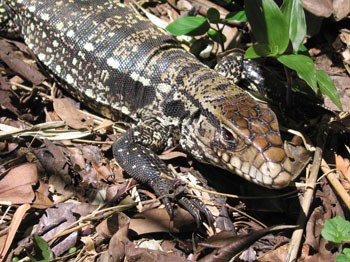
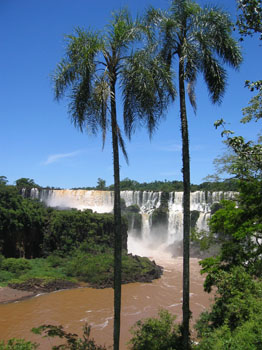
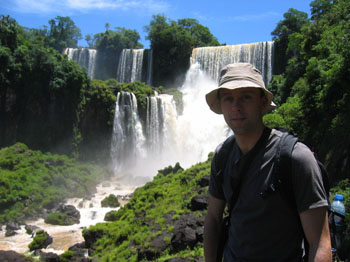
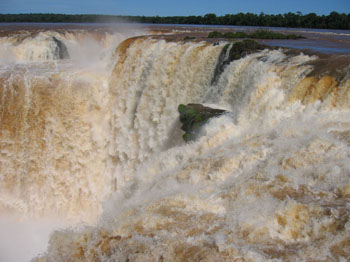
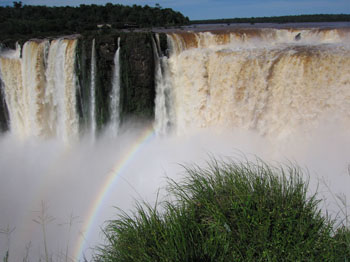
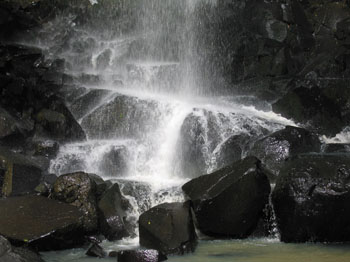
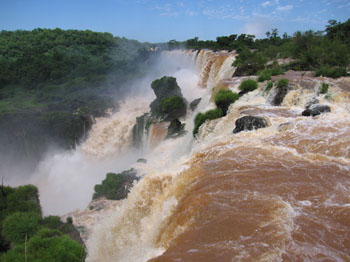
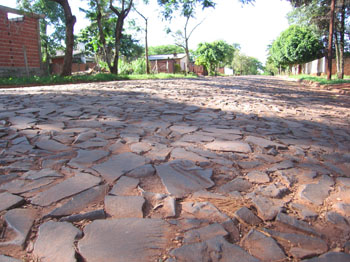
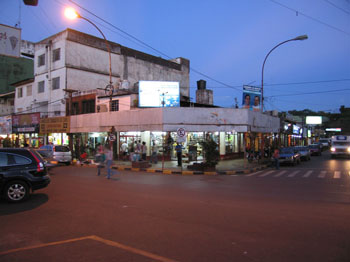
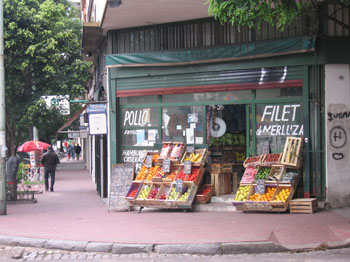
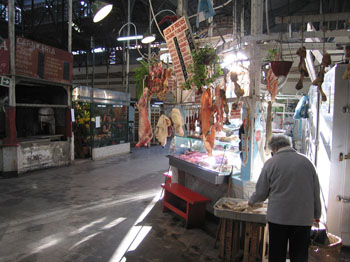
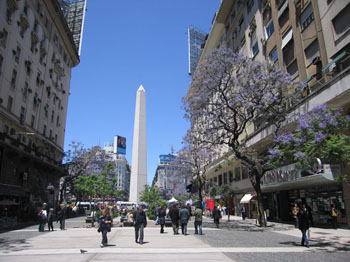
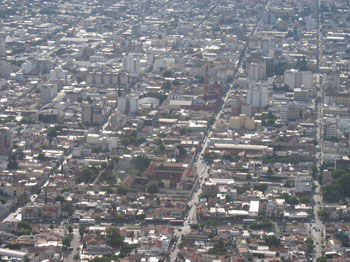
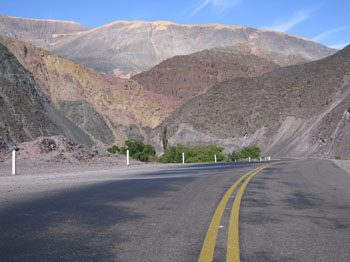
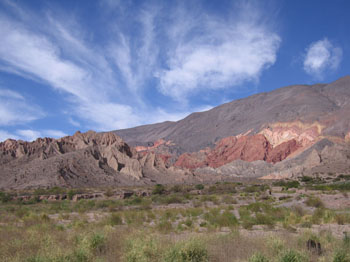
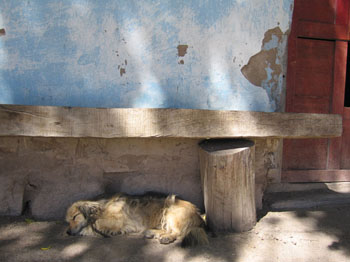
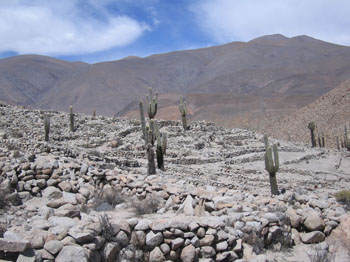
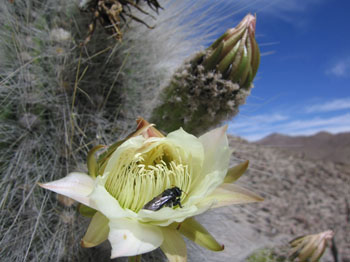
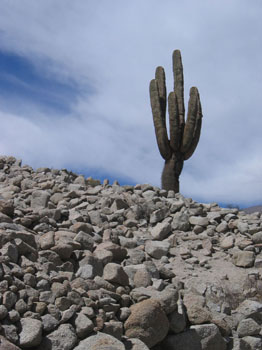

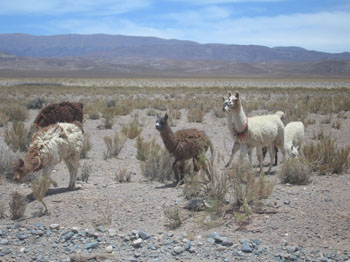


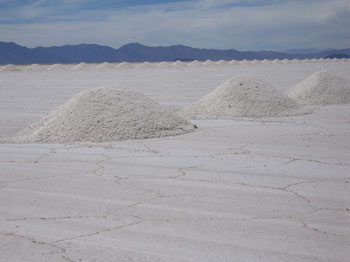
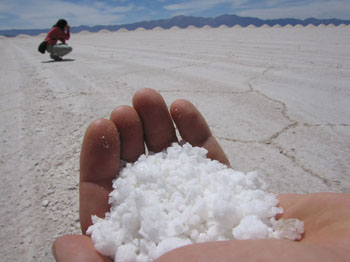
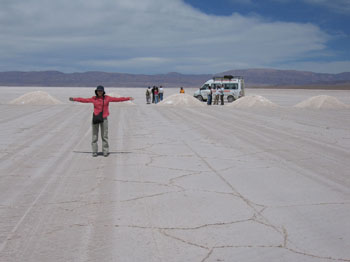
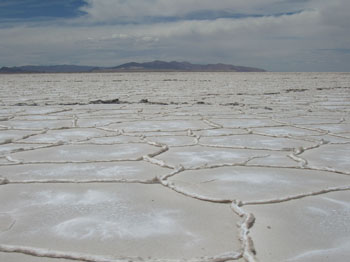
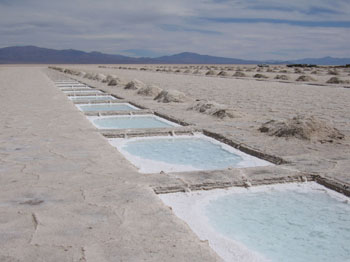
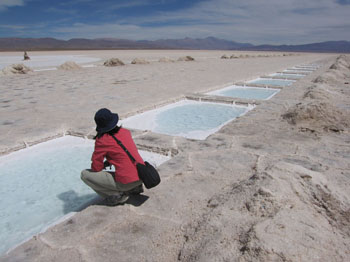
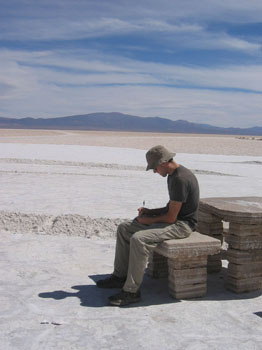

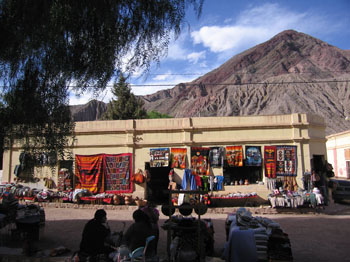
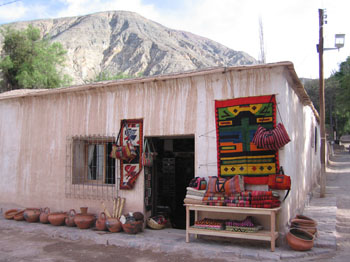
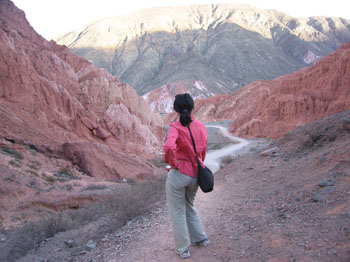
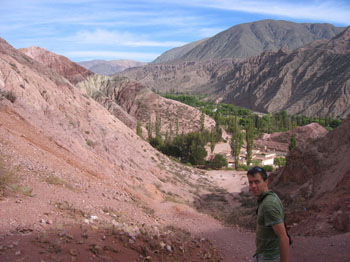
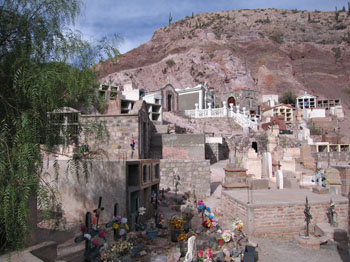
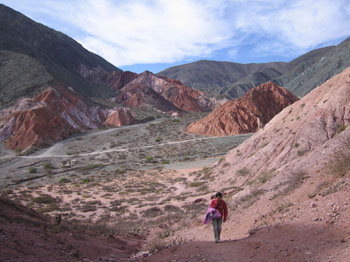

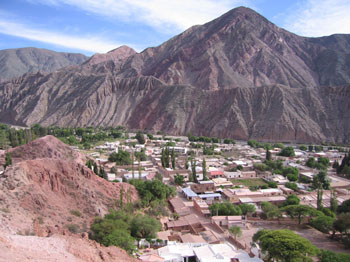
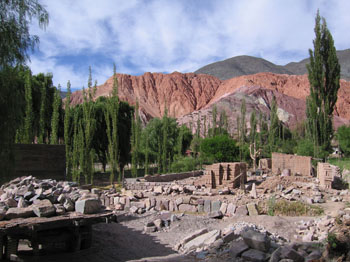
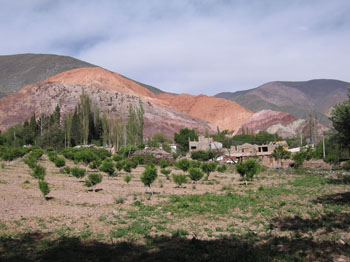

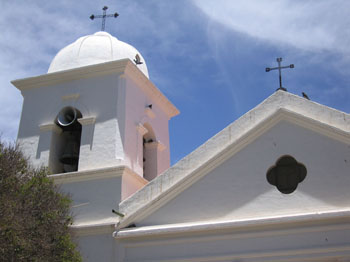
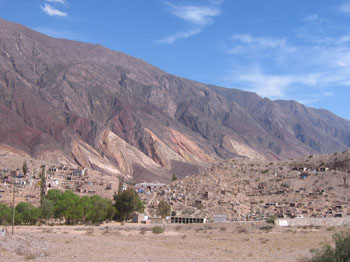
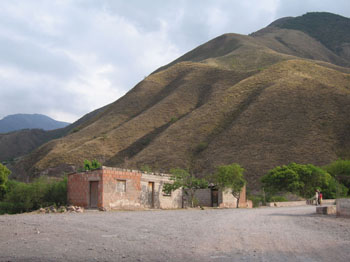
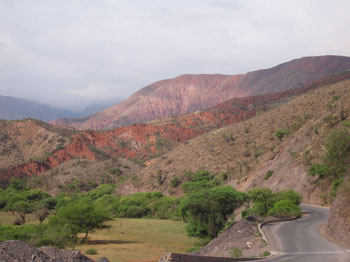
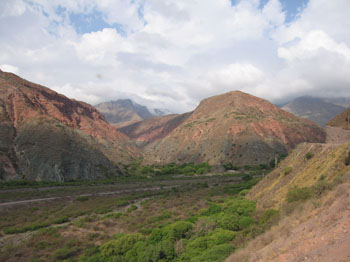
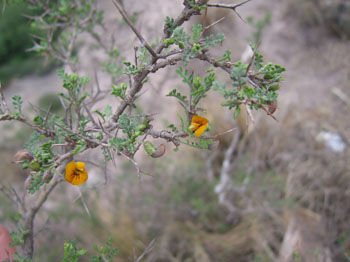
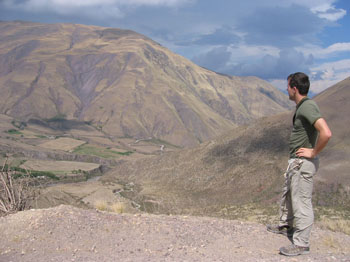
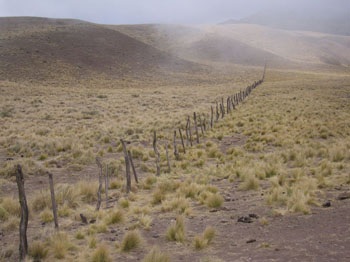
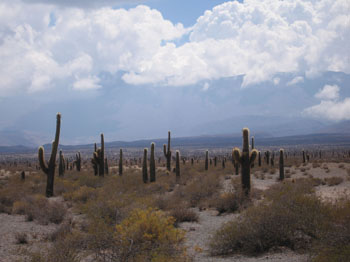
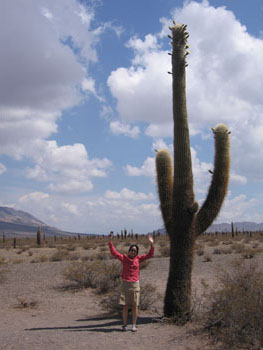

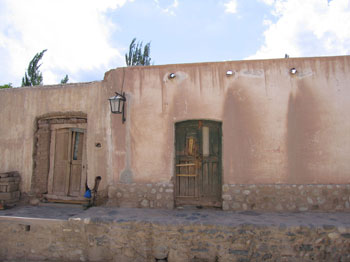
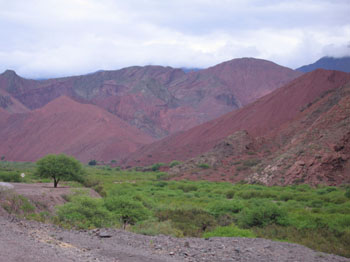


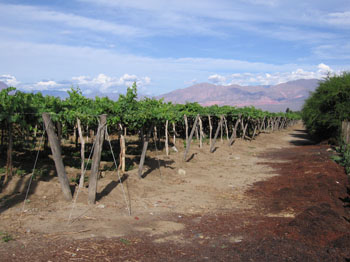
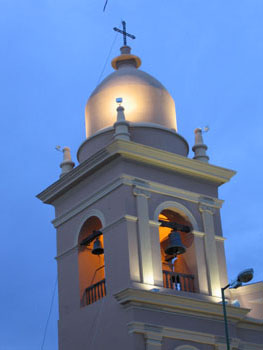
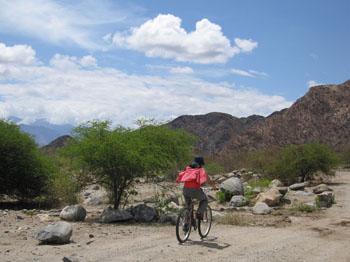
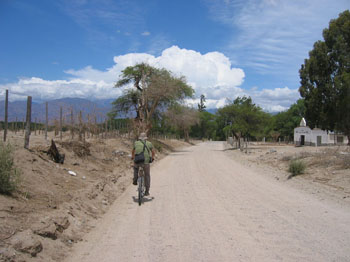
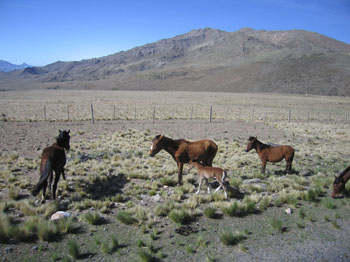
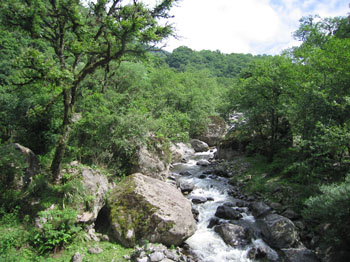
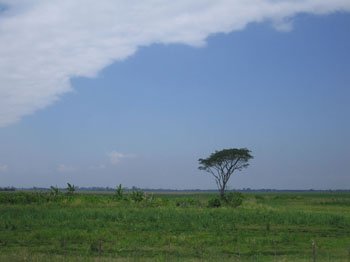
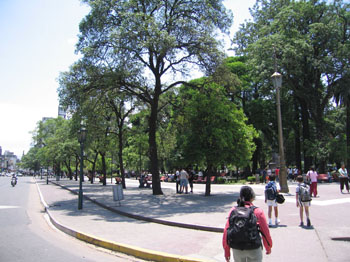
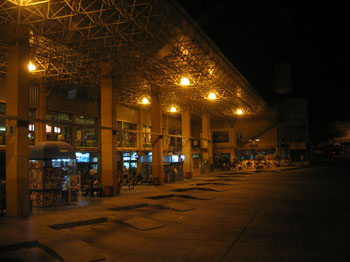

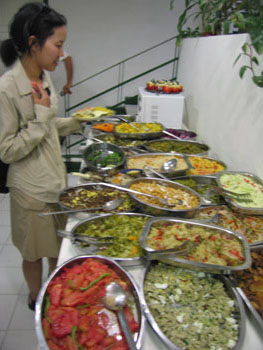
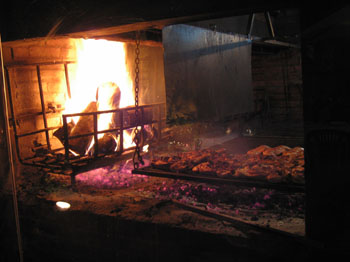
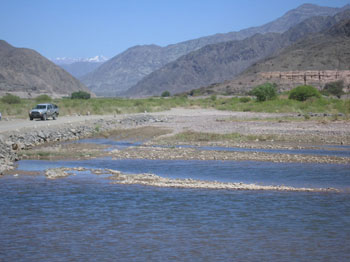
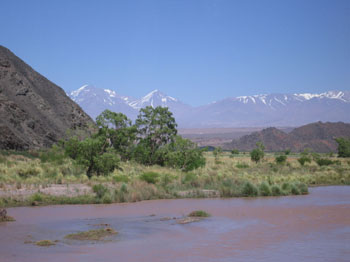
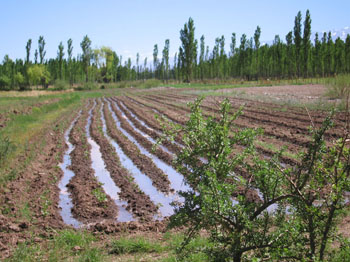

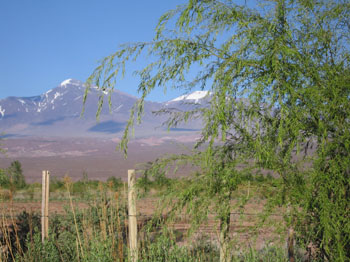
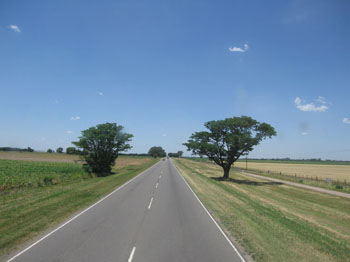
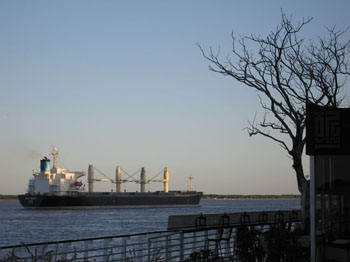

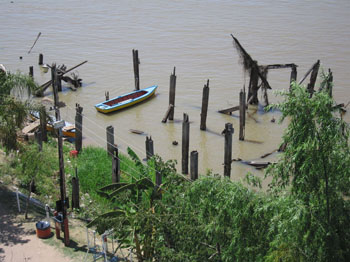
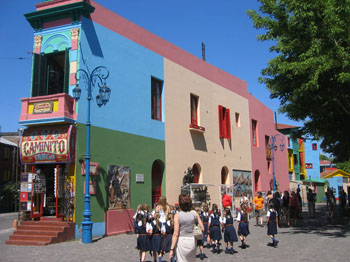
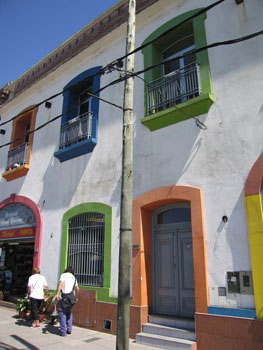
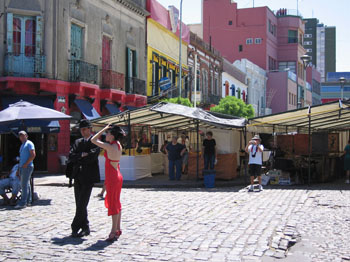
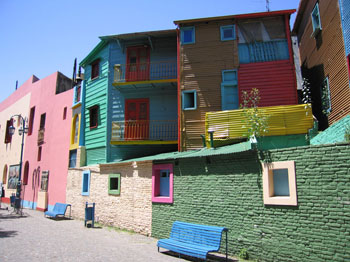

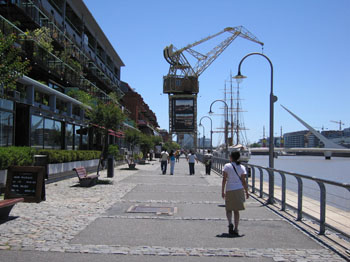
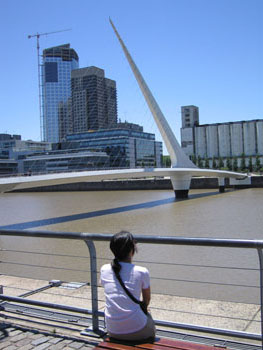
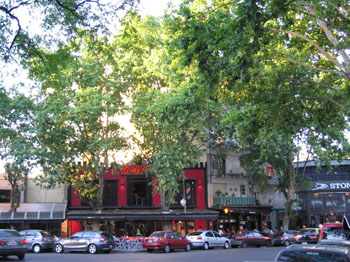
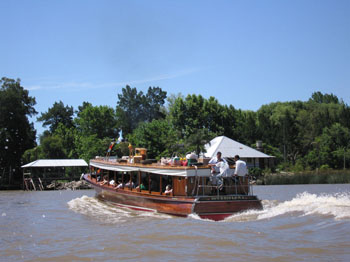
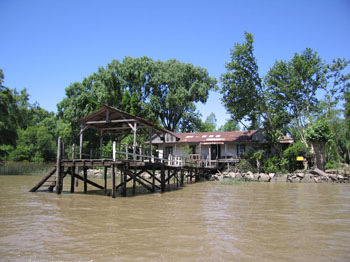

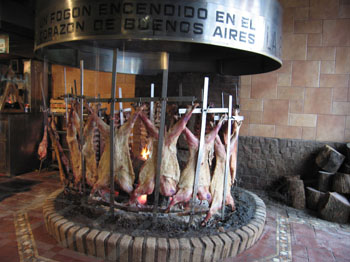

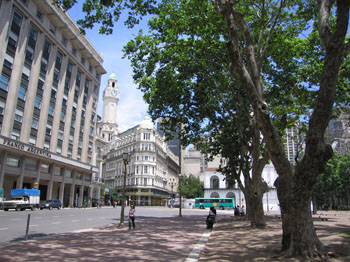
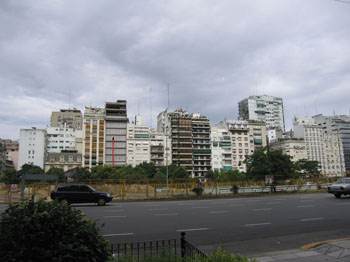
Soft pink light from a Bolivian sunrise woke me after several hours of sleep. My neck was stiff but there beneath my airplane in the pale light of morning was a dreamy blue lake nestled among rocky forested hills with a tiny clutch of village lights glimmering orange at the end of the valley like embers in a spent campfire. Off at the horizon were ragged brown peaks of the Andes mountains, some streaked with snow, and aside from the village there was not a sign of habitation - not even roads. It looked like a wonderful place to explore, if only I could get down. Trapped behind my window on a jet plane racing south I could only reminisce about my travels through the lands below four years earlier and wonder what Argentina would be like. More European, they said, and colorful and diverse with immigrants from all over the world. It sounded like the best of everything South America had to offer.
Joy and I were setting out on the year's grand adventure, a three week long journey through northern Argentina. I felt surprisingly indifferent to our departure. Things had been very busy at work, and lurking in the back of my mind was discontent from not having planned anything before leaving for a distant country I'd never visited. Joy had made hotel reservations for the first week and bought plane tickets for us, but I'd hardly had time to think about our plans and my subconscious expectations were that I would fly down, have a look around, and be home after dinner to make some phone calls and work on some reports.
Instead of returning to wintry brown California the plane landed a few hours later among cottonball clouds drifting over green fields of grass. It had rained there the night before and everything was crisp and clean and fresh. People were out enjoying a slow Sunday, drinking cups of espresso at sidewalk cafes and walking their dogs along shady streets while vendors tended to their shops and restaurants. This was in Palermo, a trendy upscale neighborhood where we had a comfortable hostel and a good meal waiting. Thrown off balance by the time change and shift in surroundings, we wandered the streets and bought lunch and returned to our room for steamy hot showers.
Toast with juice and a grilled chicken sandwich at noon wasn't much food to get me through the day so I was elated to discover restaurants packed with people when we set out at dusk, around 8pm. Selecting one crowded place with dim, warm decor and a tantalizing menu, we were ushered inside and advised that dinner wouldn't be served for a half hour more. Sipping drinks, we heard the conversations around us start to fade and found that the restaurant was emptying rapidly: the busy cafes were all serving Sunday evening coffee and cookies and just one other table at our restaurant had dinner customers. This was my introduction to the light breakfast, late dinner culture that did its best to deprive me of food and then unleash vast plates of meat all at once with little warning.
The lights were turned way down when my steak arrived. Hot from the fire and glistening with juice, the great manly hunk of meat was doused with mushroom cream sauce and joined on its heavy platter by vegetables and an exquisite potato souffle. Joy's roasted rabbit, concealed by tomatoes and onions in a wonderful savory stew, must have come from a very large animal - it had as much meat as there is on a cornish hen, good light meat a little like pork and it was only a quarter of a rabbit. Neither of us could finish our food.
Morning meant migration north, leaving early though our sense of time was by then skewed so far that getting up at 4:45am had no meaning. We took a taxi to the local airport and watched the sun's first rays glint off the choppy brown waters of the Rio de la Plata. Two and a half hours in the air would save us twenty hours traveling by bus; we would trade an understanding of distance and landscapes for a sense of the true extent of tree farms beyond the slender bands of forest that line rivers and roadways. Conifers grown for making paper are unfortunately a poor habitat for monkeys and nearly every other local forest creature, so I was pleased to see from the air that many of the pine plantations are separated by a network of native forest - while a fraction of its original area it nonetheless provides a compromise between man and monkey.
Our destination was Iguazu, one of the world's great waterfalls. Mist from the thundering falls rose in the sky so I could see it from the airplane as we landed at a tiny airport set into the forest between strips of grassy earth sprouting carpets of yellow flowers. We dropped our bags at a hotel and departed right away for the river, taking a bus and a small train and a series of well maintained footpaths to reach the first stunning vista. The Rio Parana cascades over a mossy tree-studded cliff in dozens of bright white falls strung across hundreds of meters of black rock. Brown iguana lizards half a meter long scamper among ferns, boats filled with tourists push upriver into the mist, and helicopters from Brazil crowd the sky high overhead, so high up that I can't imagine passengers get to see much. Down at the precipice where muddy water churns up a mist that casts rainbows across the rocky gorge one gets a much better feeling for the place.
We took a ferry across the channel to a big island that bisects the falls and walked to some viewpoints about half way up the escarpment. It was a hot day and we hadn't brought lunch, but we managed to visit most of the overlooks to enjoy the scene against a clear blue sky, which is something of a rarity there. Wanting to see everything while the weather was nice, we took the little train out to the end of its tracks and walked out to the biggest part of the falls, the Gargantua del Diablo. I wonder why it is that so many landforms are named after the Devil. Early settlers and explorers must have really felt that the land was out to get them, waiting with traps of the sorts that appear in myths and legends, showing its malicious form here and there with stupendous shapes of rock or water. At Iguazu the Devil's manifestation is the thunderous falls where the greater part of the river spills over the escarpment, throwing off rainbows and sparkling mist through which little brown birds wheel and dive to reach their cliffside nests. It was powerful, but not at all sinister viewed from the sturdy steel walkways that go right up to the cliff's edge. I'm sure the perspective from a boat is different.
Small wild guinea pigs nibbled grass along the path as we walked out at the end of the day and took a bus back into town. Joy wasn't feeling well, so we ended up staying in for the night after a light meal that wasn't intended to be dinner. Sleep was more important - we wanted to rise early to walk a forest path and look for animals. In the morning after breakfast we hurried to the bus station, took the day's second bus to the park, and started off into the forest. Right away I spotted a small forest pig along the path. This was exciting - there we were in the jungle where early rays of sun filtered down through deep undergrowth concealing monkeys and jaguars. "Animales peligrosos", the warning signs said. We crept along, searching high and low for jungle wildlife but finding only occasional groups of people who were all being decidedly un-stealthy. Didn't they know about the monkeys and jaguars? Finally we saw monkeys, crashing through the canopy over the trail making big sounds in the way that small squirrels in dry leaves can sound like bears.
Big sounds also emanated from the murky pool at the end of the trail. These came not from monkeys or jaguars or squirrels or bears but rather from tourists whooping for the pleasure of making noise while sitting under an airy cascade of water that leapt off a high cliff. Overlooking the gorge downstream of Iguazu, the little waterfall in a forest clearing was a lovely sight except for the two noisy men in gaudy swim shorts. Joy and I sat on a rock for a while hoping that they would leave, or that the large iguana exploring their backpacks would eat their lunch.
We saw birds along the trail on our way back, but the higher sun and rising heat had chased away the feeling that we were traversing untouched wilderness. Helicopters overhead were more noticeable away from the river. Insects were everywhere, crawling and flying and fluttering and dragging other insects back to their burrows, and there were more people on the trail. We had two more waterfall overlooks to visit, both towards the big Gargantua del Diablo, so we hurried back along the path and saw only some birds.
The water was higher than it had been a day earlier; rain upriver had made its way through the forest and tributary streams and now surged southward. The boat we'd taken to the island wasn't running because the current was so swift, and the multitude of small terraced white cascades that make up the falls when the water is lower had largely joined together into a distasteful brown sheet of water. That's not to say the views weren't still stunning, just different. Indigo-winged butterflies landed on our hands. Turtles sunned themselves in calm shallows above the falls. Huge tour groups poured into the viewing platforms, took photos, and moved on to the next overlook while we sat on a bench and watched the butterflies. Hungry, we took some photos ourselves and went back into the forest, boarded the little train that shuttles visitors to the main gate, and caught the next bus back to town. On a sudden impulse we got ice cream, and then at a cafe we bought a lemonade for Joy and a beer for me, and a pizza that turned out to be bigger than expected. A large pizza cost just two pesos more than a medium so we ordered that, forgetting momentarily that we just ate ice cream and wanted dinner later. Being totally stuffed at 3 pm isn't good if you want to try homemade pastas and thick juicy steaks at 8:30.
It took us a while to finish the pizza, methodically working our way through the slices while the town's electrical power went dead and the room started to heat up. Rainforest towns always seem to be a little run-down. They have a characteristic appearance - everything is made of concrete; metal rusts and wood rots or is eaten by termites. Utility poles, water towers, walls, houses, and fence posts are all concrete and many are painted white or rusty red, but the paint is soon stained and peeling from all the moisture. Men were always working along the roads to beat back the grass with weed trimmers. Even though it's a popular travel destination and surrounded by tree farms beyond the national park that wraps around the falls, Iguazu still felt like an outpost in the jungle.
To pass the time we walked around town, discovering a built-up commercial section a ways from our hotel where stores sold all sorts of trinkets, common clothing, hardware and tools, and other things that one would ordinarily find downtown. By appearances alone I had been judging Iguazu to be a little more rustic than it actually is. Darkness fell as we walked to our restaurant which turned out to be busy already even though it was early. The decor was nice, the food looked good, and as we followed the hostess to a table I was ready to settle in for a relaxing evening. Moments later my hopes were weighted down by the disappointment of being seated near the busy kitchen and the confusion of not being offered a wine list. Had we broken some rule by not making a reservation? Joy still wasn't feeling totally well, and we weren't that hungry, and the waitstaff seemed disinterested. Our food was ornate but not particularly flavorful though I enjoyed my Pacu, a river fish served with fried strips of manioc and slices of mango - all local flavors. We finished what we wanted and I paid a hundred pesos thinking how it could have bought four pizzas instead.
Morning brought rain, the cozy pattering kind that comes with intermittent rumbling thunder and goes well with a hot drink and a good book as long as you aren't trying to go somewhere. We had an afternoon flight back to Buenos Aires and four hours to spare. Passing the time at a cafe seemed like a good idea, but the rain went on for hours as we sat reading under the awning in front of our hotel and thoughts of getting wet discouraged my hopes for a hot meal and a beer. A taxi took us to the airport where we promptly discovered our flight had a 2 hour delay, but having arrived very early we were able to get on another flight and leave the seething masses of unhappy travelers behind.
In sunny Buenos Aires a bus took us to San Telmo where we dropped our bags in a lovely little hostel built in an old industrial loft space and hurried out to find food. San Telmo is an old neighborhood paved with cobblestone streets and packed with antiques dealers and cafes, one of which became our home for an hour while the sun sank low and brought rich colors out of every car and building. I liked the antiques shops. We only browsed our way through a few of them but just looking through the windows was enough for me to absorb a feeling of old Buenos Aires, decades ago before the 2001 economic crisis, before political suppressions and far-right politics. Argentina is past those troubled times now but I prefer San Telmo's old alleyways and dusty shop fronts to Palermo's chic stores. It's a visitor's perspective that makes the time-worn things seem quaint.
I had my stomach set on a parilla - a wood-fired grill restaurant - that we passed on our walk through town but when we arrived after finishing our tea the place was open but mostly empty so I decided we should return a while later to enjoy the restaurant when it was more lively. This happened at around 10pm, or perhaps earlier since by then a small pig had been roasted and was out on the carving block and slabs of meat were draped on a grill over red-hot embers and people were well into their wine and plates of food. If you ordered meat, that's what you would get at this parilla: a plate with a piece of meat on it. We ordered sides: carrot salad and an arugula salad. A plate of shredded carrots arrived, and another of chopped arugula, along with an assortment of olive oils and vinegars. My steak was an inch thick and almost as big as the dinner plate, pink and juicy and seasoned with salt. Joy got a cut of pork and we drank some wine and when we were finally finished eating at midnight the bill was just thirty dollars and the restaurant was still packed with people.
Joy noticed that my airline reservation wasn't listed on the internet site anymore. Fearing that my ticket had somehow been canceled when we changed our flight the day before, in the morning we packed our bags and set out for the local LAN office after the receptionist at our hostal couldn't get through the sea of automated phone menu options to ask about the ticket. Fortunately LAN has an office near the city center, where we could walk around and get lunch before heading off to the airport again for our flight to Salta. Its representatives spoke some English, but they weren't very good at using the computer system and it took us four tries with three different people to get our confirmation sheets printed out so we would have something to present at the airport if needed.
Empanadas from a cafe made a tasty lunch though the cafe was crowded because we were in the financial district with thousands of business people on midday break. We walked around the theater district and looped back to catch a bus to the airport. On the plane they showed the exact same videos and served the same snack boxes with cookies and crackers. I turned my attention to 'Zen and the Art of Motorcycle Maintenance', looking out the window from time to time to watch daylight fade from the hazy brown land below.
After dark the plane landed in Salta and we got a taxi to our hostel. It sure was nice that Joy had made reservations in advance - after a long day it was nice to have waiting a place to sleep even if it was a run-down building lacking all charm and in need of repairs. Our windowless first floor room had a bed and a small wardrobe, and the sheets barely fit on the bed so they would pull off at night leaving the mattress bare. It was a cheap sleep though, and there was a kitchen and internet - sometimes - and we met some interesting people, the sort who get excited about three peso campsites outside of town (our private room cost 55 pesos, at 3 pesos per dollar, almost a third of what we were paying at nice hostals in Buenos Aires) and hadn't heard of any of the places we planned to see in Northwest Argentina. Travelers either have lots of time and no money to see anything, or enough money to get around but scarcely enough time to get to know the places they see.
In the morning, we set out to find some tours that would take us into the surrounding hills to colorful rock formations, salt flats, and vineyards. My memories of similar landscapes a short distance away in Bolivia were paired with suspicions that as in Bolivia, the tour operators could be banded together to inflate prices. Four years earlier in Uyuni I visited several operators to see the offers and took the one that sounded like the best show for the lowest cost, then boarded my Land Cruiser and discovered that my travel companions had just booked the same thing at another agency for substantially less money. Everyone was selling the same thing under different descriptions with different prices. Fortunately in Argentina there is some regulation, even a tourist office with posted prices, and we soon had our next four days planned.
We ate lunch, tried a local dark beer, took a cable car to the top of a hill overlooking town, and walked down through a locust forest that was just getting its delicate green spring leaves. Many people were out walking and running on the stone-paved path which being steep is fantastic exercise for those who make a habit of climbing it. For dinner we bought groceries and cooked some pasta at the hotel. The meal wasn't great, as we were limited by kitchen space and ingredients, but the local restaurants weren't very exciting either and saving a little money felt good.
A white van with big windows picked us up at 7am and proceeded around town to collect more passengers. Our guide, Claudio, spoke English and explained what was going by outside as the driver steered into a dusty river valley and headed upstream. We were following train tracks that sometimes carry the famed "Tren de los Nubes - Train of the Clouds". A spectacular engineering achievement even now, it is costly to maintain and not presently operating (November 2007) so tourists go by bus along much of the same route. I would rather have taken a train. On the bright side, unlike the train our van stopped from time to time and we scrambled out to take photos.
One stop was at a hilltop fortification from pre-Inca times. It was miserably windy there, on a stony hill rising perhaps 50 meters above the valley floor at an excellent defensive position otherwise inhospitable and devoid of life except for tall cactus plants. These were flowering, each plant sporting several pale yellow flowers near the tops of its branches. Rebuilt circles of stones covered the hilltop. Hundreds of years ago they might have sheltered tents; evidently no remains of more substantial structures have been found.
Our van climbed higher into colorful desert hills and then emerged onto the great flat plains of the altiplano. We stopped for lunch at San Antonio de los Cobres, a small and poor mining town where grimy children crowded around and thrust bits of rock and small handicrafts toward us. Most of our group, which was about 12 people in total, ate at the designated restaurant but Joy and I had brought some bread and salami and cheese which we took to the edge of a small stream along the main road through town. Sitting along the stream bank, I was just about to make sandwiches when a group of kids raced over and sat down and stared at us for a full five minutes. They weren't asking for food, and they quickly gave up on the idea of selling us anything, but still they stayed and it seemed improper to bite into a big sandwich while being watched. Eventually they left, and then two boys came by but didn't stay, and then a dog visited us, and finally we ate the sandwiches and walked up and down the street and sat for a while until it was time to go.
Following a dusty dirt road across flat plains, we saw herds of llamas and solitary adobe houses and once, a group of vicunas which are a now rare deer-like animal prized (and hence killed) for its super-soft fleece. In Inca times the people would herd all the wild vicunas into corrals once a year and shear them, then set them free. Today there are not many left and poachers take some. Farther on, we came to salt flats which turned out to be more brown than the one I saw in Bolivia. The salt was still blindingly bright in the sun. Mining by government permit, a small group of people maintains salt pits which are rectangular depressions about 1x3 meters and 50 cm deep. Digging the pits removes all the dirty brown salt and then water seeps up from below and evaporates. This causes salt to concentrate at the surface, where it crystallizes like floating snowflakes the size of a half-dollar coin. Eventually these get heavy enough to sink, and once a year the fallen salt flakes are scooped up, dried, bagged, and sold for about 12 pesos per ton. 12 pesos will buy two beers; it's not much money. Evidently workers bring home about 350 pesos per month from the salt operation. Despite these sobering numbers the cyan pools of water laid out in a rectangular pattern were very pretty to look at.
Beyond the salt flats the road crossed a high pass at an elevation of 4170 meters and then descended the Lipan Slope, a series of switchbacks dropping the road 2000 meters in 20 kilometers. We arrived in the colorful little village of Purmamarca late in the afternoon and took our bags to a hotel. The van would return to Salta, then pick us up in the morning with a fresh tour group going north to Humahuaca. Purmamarca was an idyllic place surrounded closely by red and gray and gold hills. There were fruit trees and vineyards among the adobe buildings and poplar trees lined the streets. To the northwest, right behind the town, the famed "Hill of Seven Colors" showed its stripes of purple, pink, red, gray, green, and gold. I could only count those six colors.
At the center of town the main plaza was filled with vendors mostly selling the usual weavings, sweaters, hats, mate gourds (these are gourd teacups used by many Argentines for drinking afternoon yerba mate tea), carved salad spoons, and other trinkets. It was pleasantly surprising that not one of the vendors was pushing any wares. All simply sat back and only presented alternate options once we started to look at something specific. I bought a weaving, and later the next morning I found another that was different than most. Made by a particular tribe, the Wichi people from the chaco grasslands, it is made to look like a cave painting with stick figures of llamas, serpents, and other shapes against a warm mottled background. The Wichi aren't traditionally cave-painters or weavers but since much of their land has been taken away and covered by soybeans, they sell crafts and some of them are unique among all the usual Andean goods.
A walking path loops around the colorful hill. Back in the dry wash behind town, the colors are even more stunning especially in the warm light of late afternoon. A pink and white and green ridge angling up against a larger hill looked like the arched back and tail of a giant prehistoric lizard and across the dry wash there were layered white and pink pyramids and rocks swirled with color like great blocks of ice cream. We rounded a rise behind the town and looked down at the green oasis nestled in its narrow valley looking so comfortable, one of the prettiest desert towns I've seen. Along the way down we passed two young boys playing with an adorable days-old little white lamb that scampered around like a toy stuffed animal.
It was too early for dinner when we made it back to the central plaza, so we sat for a while on a bench and listened to darkness fall. The vendors were packing up, carting away their goods and going home. Families were out walking and stray dogs raced around chasing each other. I had a restaurant picked out from explorations earlier in the day. Its colorful Andean tablecloths looked cozy and warm, and somehow I was sure the food would be good. Just walking there from the plaza we passed aromas of cooking food so enticing that it was hard not to be caught peering through the windows of houses to see what was being prepared in the kitchen. We ordered a few things from the short menu and soon our steaming plate of humitas arrived. Humitas are like tamales, steamed or grilled corn mush wrapped in cornhusks, but they don't have a meat filling. In Peru I bought them from train and bus windows, hot off a grill and so so good, sweet and steamy with bits of corn and a taste of the toasted husks. I can't ever seem to find them in the US; they use a kind of corn called "choclo" in South America and its huge white kernels are considerably less sweet than common corn grown at home.
The humitas were spectacular, and before we had finished them our other plates arrived: lamb stew (cazuela de cordero) and locro, a corn soup with meat and vegetables. Locro is a common dish and it's made in myriad ways none so good as what we ate there in Purmamarca. Our food was perfectly seasoned, filled with green beans and potatoes and tomatoes and other vegetables in addition to tender roasted meat. Little morsels of lamb drenched in savory sauce nearly melted in my mouth. The potatoes were golden and tender and there were slivers of onion and little nuggets of tasty corn mingling with the tomatoes. The meal was clearly made by someone who understood food, and this was sharply in contrast to almost every other restaurant we visited in Argentina. Of course our parilla steaks were good, and we had some fabulous meals in Buenos Aires, but outside that city it seemed that cooks were all trying to mimic the appearance of food they's seen somewhere, without really understanding its flavors or what would make it taste truly good. As we scooped up every last morsel of our meal, I was so pleased not only to have enjoyed such a good meal but also to have solid proof that the cuisine of the Andes is alive and well, just hidden away in little restaurants that are well supplied with both ingredients and culinary skill.
I shouldn't under-stress the supply of good ingredients as a factor here. In Purmamarca I was rather surprised by the quality of homes and businesses. Many were under construction, the school was recently built with attractive adobe and stone architecture, there were many sattelite dishes hanging off the eaves of eroded mud brick homes, and throughout the town it was evident that money was flowing through in a way that no other mountain town could match. No doubt this has something to do with the busloads of tourists who come every day. If this is what it takes to bring delectable ingredients within the reach of Andean cooks who can make soups and stews like we ate, then I wholly endorse the system.
This inflow of cash also brought us one of my favorite hotel rooms of the trip. It was simply new, clean, and had a big window opening out toward the town and a beautiful mountainside. There were stars shining brightly overhead when we returned after dinner, but it was chilly so we closed the window. In the morning there was breakfast at the hotel cafe, and we went walking again around a shorter trail that looped up over the Hill of Seven Colors. Around 10:00 we rejoined our tour van, along with two French girls who were with us on the tour the day before. Leticia and Sylvia were flight attendants on Air France. Joy's French turned out to be a good bridge between broken English and what little Spanish we could all understand, as we had a fun afternoon driving up yet another colorful desert valley to the town of Humahuaca, getting lunch at a restaurant, and returning to Salta via the forest town of Jujuy where it was hot and humid.
We made sandwiches for an evening meal, washed some clothes, and later bought a late night snack at the nearby hot dog stand. I would have bought ice cream too, but the heladeria was absolutely mobbed. It was Sunday night and a hot and sticky one too; everyone was out. In Salta they observe a midday siesta of several hours, and everything stays open late to get a full day's work in. Even so things start to close up around 10pm, which was about when we went back to our room to sleep. It would be another early morning the next day, with another tour heading off into the mountains.
I was surprised to discover that our tour to Cachi was in a little Renault car with a driver, rather than a big van; our two travel companions Ian and Terri, tourists from the UK, were finishing a three-week trip that had taken them by bus through the pampas and Iguazu. Our driver, William, spoke English reasonably well and told us endless facts and stories as we passed tobacco fields, then lush forest, then high pastures and finally wind-swept altiplano. Our guidebook described the road to Cachi with all sorts of dramatic words, but perhaps having seen two days of stunning landscapes already I found it not quite up to expectations. Still it was nice to be out seeing the countryside and getting a feel for the area.
One impressive section of road cut across a wide valley filled with cardon cactus, thousands of them stretching across miles of empty desert in unisial abundance. A park has been established to protect them, necessary because although there are many, they each take several hundred years to reach the size we saw in such abundance. We stopped for lunch at an over-priced goat farm and restaurant where we ate salty fresh cheese and plain but pretty food. Cachi, the town we'd come to see, was empty at midday and rather hot. The big white church looked like many others we had seen. Stone mortars and pestles at the archaeological museum showed wear from decades of use in ancient times. There wasn't much else to see, and on the drive back I was very sleepy. It felt like time to leave Salta and go south.
In Salta it rained, steadily all evening once we returned and hung the damp clothes on an outside line - fortunately there was another clothesline under a roofed area so the clothes could dry a little longer before I brough them inside. We wrote postcards and I put on my jacket and went out into the rain to take them to the post office mail drop, managing to sneak out one postcard with a short note sent to Joy's address.
In the morning it was still raining. Another tour van this time with a new driver and guide picked us up at 7am and headed south toward Cafayate. In the northwest they pronounce the "y" sounds as "ch" so this town sounds like "cafachate". There were more pretty desert landscapes, and some eroded waterfall canyons that would have been amazing with some water in them. I was glad we weren't going back the same way to Salta like everyone else; the scenery was losing its charm. A good condensed trip would be our first day's tour to Purmamarca, then a public bus down to Cafayate for a day exploring the vineyards by bicycle.
Wine is a big industry in Cafayate, where they make white Torrontes wine and a few reds such as cabernet, tanat, and malbec. Our tour stopped at two wineries where the tasting was included in our visit so we stayed with the group through lunch to taste the local fare and get abbreviated tours of the wineries. I found the reds rather bitter, but at Nanni our English-speaking French hostess spoke so highly of their prized limited edition wine, a red made from a mix of grapes, that I decided we could take on a new role as rich American tourists to stand out from our glum European and Argentine companions by buying a bottle of this stupendous 18-dollar wine for drinking later in the afternoon. I was feeling a little unhappy that our big busload of sixteen people had come and tasted and was gone out the door with hardly a word. Joy filled me in later on the grumblings of the impatient Austrian couple seated next to us. They didn't seem to be having much fun and must have thought that no one else would understand their muttered verbal attacks on the unlucky people who were ambling slowly back to the bus after lunch. That was just before we took our bags and left, free to do absolutely anything we wanted. Nothing more was planned until our last two nights in Buenos Aires.
The logical thing to do was of course to go find a hotel, take off our shoes, uncork the wine, and enjoy a lazy afternoon of conversation and crackers and cheese that we happened to have in our bags. It would naturally be best to do this in a quaint courtyard shaded by grape vines and furnished with comfortable white-painted wrought iron chairs and tables, and it would be fantastic if we could do this with a maid to bring us glasses and plates and a tablecloth. Accordingly we went to Senora Mirta's hostal near the central plaza and got a room for two nights, beside a shady courtyard appointed with the desired vines and furnishings and adjoined by a larger courtyard surrounded by trees laden with still-ripening figs, oranges, plums, and apples. Senora Mirta is an older woman who chain smokes and wears angular rimmed glasses and keeps her dark hair in a bun and wears long dresses and blouses in a style that made me think it might actually be the year 1922. Joy said it felt like we were in the Great Gatspy.
Furthering this feeling, Senora Mirta lived on the premesis in a room adjacent to ours and freely called on the services of Elisa, the maid who did the laundry and washed dishes and looked after the place. Even the dishes seemed to be from a byegone era. The old hot water heater was a type that had to be fired up right before use and turned off afterward, so we had to order our showers from the maid. Senora Mirta brought us a cork puller and Elisa set a table for us in the courtyard. The wine was good, smooth and complex and dark though not spectacular enough by my taste to go buy more bottles. We worked our way through half the bottle and our crackers and cheese before venturing out to visit more wineries and eat some of the famed wine ice cream they make at one shop there. It really was wine in ice, Italian Ice style with no cream, full of flavor just like the torrontes and cabernet. I was impressed, and resolved to make my own upon returning home. I don't know if they percolate wine through powdered ice or actually freeze the wine; it was rather soft though probably on account of a lowered melting point due to the alcohol.
I felt awkward at the wineries we visited. Even in California I feel awkward because I don't feel compelled to expound upon the virtues of wine; I have little to say about all but a few of my all-time favorites. Doing this in an empty tasting room speaking in Spanish is well above my level of comfort. At one winery the girl at the counter spoke excellent English but for most of our time there we were alone and struggling to make conversation about the local wines without knowing hardly anything about them or about wine in general. It was nice to see the wine cellar there as part of a personal tour. It was small and I really got a sense that they were hand-crafting wines for enjoyment rather than for business.
We went back to the ice cream shop again and again, eventually trying almost all their fresh fruit flavors which were exquisite. They tasted like the first bite into pear or pommelo or mango or peach, a delicate flavor that is almost always lost in any cooking or freezing. For dinner we tried a recommendation of Senora Mirta's, only to realize that like sheep we had been herded there to earn her points probably toward a free meal. She sent us with a little signed note. Our waitress smiled and said "oh, la Senora Mirta..." almost with a sigh. The food turned out to be good though, cheap and quick and tasty and not too big, just what we were looking for.
In the morning we rented bicycles for half the day and headed for the outskirts of town intending to see some vineyards and views of the valley. Riding was pleasant in the cool of morning but there was an alarming quantity of squashed toads, big ones, on the gravel road. It had rained recently so perhaps they all came out at once. In any case, their distribution along roadways all over town suggested that there must be thousands more off in the ditches and hedgerows. The place must literally be hopping when it rains. We were riding uphill on hard packed dirt with big stones and it was hard going, partly because of the sun and heat. We passed a big tarantula spider and I followed it off into the scrub brush for a while wondering how it was navigating.
It was hot and the road was rough. There were wineries about but we didn't feel like drinking wine especially with the language barrier making conversation such a challenge, so we turned back and rode into town to get lunch. They called it a pizza but it seemed like a pre-baked big circular slice of dry bread with a little tomato and cheese with basil and oregano. We parked the bikes beside our outdoor table and drank the 1-liter bottle of soda the waiter brought with our pizza. In Argentina there are two sizes of water or soda: a small at about 10 ounces and a large at 1 liter. Even beers came in huge bottles, though they were 750 ml rather than a full 1000. It's so dry though that you always end up drinking the whole bottle, even just at lunch.
Next we bicycled down the valley and explored a little artist's hamlet, getting a quick tour of a ceramics studio by one of the artists. He spoke English well. "We make a little wine, some pottery, my girlfriend makes all these sculptures," he said pointing to a room full of small cartoonish characters. In back there was a crumbling adobe oven that they used to fire the pieces. Riding onward we circled back into town and waited for siesta to end so we could return the bikes. The sky was dark with clouds and it started sprinkling as we walked back to our room; this turned to a rain shower that lasted just long enough to soak the streets.
Sitting at the edge of the wet courtyard where the roof extended and kept a table dry, we finished the wine and waited for the dinner hour. The rain had stopped and I went out to buy some food for the next day's bus journey, finding oranges at a market and a loaf of fresh bread from a bakery across town. I also spotted a good restaurant that we returned to at dusk, after buying a roll of packing tape to wrap up our boxes of wine for safer traveling.
Even the stray dogs were still sleeping when in the dark at six in the morning we left our quiet hotel and hauled to the bus station our heavy bags laden with wine bottles and weavings and Joy's new photo album. Our bus was going to Tucuman about six hours to the south but few people would be traveling all the way there. Men and women wearing sidearms and neatly pressed blue police uniforms rode from one town to the next making their morning commute. After sunrise, school children clambered on and were delivered to their school. We bumped along dusty dirt roads and watched the day's events unfolding: a man cleaned an irrigation ditch. Piglets romped around in a barnyard. Long shadows shrank as the orange sunlight brightened to white and began to warm the bus. More children got on, and one of their teachers, and the bus began to grind its way up a steep sinuous road past stands of cactus. Evidently the cardon cactus is protected by law. The plants grow very slowly taking hundreds of years to reach heights of 3 or 4 meters so chopping them down for firewood or fenceposts would quickly destroy them all.
The children got off around 10 am at a small white school building high in the hills, racing exuberantly down the driveway to meet friends who were already playing outside. The school must be half-way between two remote areas to serve them both. Continuing on past golden grassy fields where baby horses frolicked beneath blue sky with puffy white clouds, we rounded a bend to see a lovely blue lake and patches of green forest below. This was the town of Tafi de la Valle, a popular vacation spot for people who come up to escape the heat of the central plains. There is even a yacht club on the small lake. From there the road plunged into a verdant forest of ferns and birch trees and a playful mountain stream that leapt over gray boulders and crept under overhanging mossy trees. A terrifying gorge soon appeared, deep and steep and primed for a massive mudslide that could sweep our bus away. Carpets of bright spring flowers sprinkled over deep green grass beside the road and ripe wild strawberries in sunny spaces were like bait in a trap, luring unwary drivers over the edge to the sinister looking depths where great skeleton-like trees draped in drab olive moss harbored darkness from the night before.
There were fantastic thickets of cherry-red, lemon-yellow, and pumpkin orange flowers all clustered together. Farther along, pale pink and white blossoms graced the roadsides and back in the trees there were baby blue blooms crowded on mossy rocks and bursts of red hanging from small trees. The road dropped down to the river and became less steep, tunneling into a forest of bigger trees and then speeding out into an immense flat plain that stretched off to the horizon. We settled into our seats for a long dull ride. Outside, there was corn.
Trees shade the central plaza in Tucuman and they provided salvation for us after we carried our bags through the heat from the bus station. Even with the wine stashed in a bus station locker, the bags were heavy. Our guide book described the city as the birthplace of Argentina's independence and still home to a revolutionary undercurrent. Looking around from a bench in the plaza this appeared to be quite true: in front of several buildings there were riot police standing in casual lines behind their plastic shields and at the opposite corner of the square a fervent demonstration was under way. I couldn't make out what they were saying. After ten minutes the crowd broke into smaller groups and dispersed, still chanting and cheering as it rejoined the afternoon shoppers and businesspeople on the sidewalks.
We hauled our bags to a nearby cafe and sat inside where air conditioning chased off the heat. A pitcher of lemonade never tasted so good. I ate one of those special Argentine meat sandwiches: the "lomo" is a big sandwich with beef and ham and a fried egg and tomato and lettuce, dripping with grease and wonderful flavors. When that was gone it was siesta time and everything was closed except ice cream shops where we bought tall cones and sat at a table trying to eat them faster than they melted. With its flat hot sprawl of concrete, Tucuman wasn't wooing us to stay. We bought a big bottle of water and walked back to a park near the bus station, brushed our teeth, and rested a while before picking up some snacks for an overnight bus ride to San Juan.
Lightning flashed in the western sky as darkness fell on our bus. In little towns along the way south the bus would turn onto impossibly narrow streets and make its way to most inconvenient bus stations that glowed orange in the light from sodium lamps. The attendant served us a hot dinner, airplane style but plainer, just meat and potatoes and bread. Outside I watched the streets go by telling a thousand stories in the dim light. Cuddling couples standing in courtyards were in plain view from my second-deck seat. Motorcycles puttered past carrying revelers back from nightclubs. Later, I awoke to a spectacular storm of lightning sparking across the sky all around. The storm was so intense that I couldn't believe the sound of thunder was too soft to hear. Hurtling forward through the dry darkness, the bus crossed the electrified desert without hesitation and I shut my eyes and tried to sleep.
Sunrise showed a sea of dust and gravel with scattered trees. At the bus station in San Juan, vendors were hawking newspapers and hot tea and loaves of bread. Under wooden benches inside on the tile floor, four or five stray dogs were sound asleep and oblivious to people walking around and sitting on the benches above them. Paws swept air aside in doggy dreams. Apprehensive at first, we watched for a moment and finally eased our bags into place and sat above some of the dogs. None stirred. It would be early to expect an available hotel room so we tried to rest a bit before leaving the station. One by one, the dogs awoke, stretched, got up, yawned, looked around, and trotted out the doors into the morning sunlight. Each had a clear appearance of purpose; there was no frivolous chasing of cars or begging for food. These dogs looked both ways before crossing pavement.
We waited for one of the bus offices to open at 7:30am and then bought two tickets to Barreal departing the following morning. It seems that only one company serves that route, and departures are infrequent. We were fortunate to be departing on a Saturday, the single day of the week having a morning departure, else we would be arriving in the middle of the night in a small mountain village where nothing would be open. This trip would set in motion the last part of our travels, up into the Andes and then back down and across the plains to Rosario and Buenos Aires.
A hotel around the corner miraculously had a room ready at 8:30am and there wouldn't be any extra charge for arriving so early. Hot showers refreshed us and then we set out across town to inspect dinosaur fossils at a small museum where staff labored over workbenches using tiny tools to clean sharp toothy fragments of animal skeletons from millions of years ago. It must be nerve-wracking work chipping away at something so irreplaceable. It was time for lunch and we knew of just the right place to go for a refreshing meal of vegetables, that food group sadly lacking from most restaurant menus. In San Juan there is a little vegetarian restaurant that serves up dozens of hot pans of food, and some chilled ones, all stacked on tables with pans of stir-fried snow peas propped atop dishes of stewed tomatoes with green bell peppers, alongside seasoned carrots and a fabulous pan of cooked corn and vegetables. There were some casseroles and different kinds of ravioli and bean dishes, eggplant parmesan, quiches, fresh salads and potato dishes and even pizza, and a long line of people - almost entirely women, most wearing business dress - waited to pay by the pound for styrofoam containers they'd packed to go. For a flat fee of 17 pesos (about $6, and the price of one kilogram take-out) we could get a table. We bought some fresh squeezed juices and did our best to each eat at least kilogram of food. There was fresh bread too! It was the best meal since Purmamarca.
I wondered where all the men were eating lunch and we soon found some of them at a steakhouse, drinking beers and eating meat and fried potatoes. We walked past on the street and sat in the park for a while. I noticed that the sun was almost directly overhead. Light posts and people had tiny shadows - we were in the tropics in summer! It was cool and pleasant though and I hoped the weather would hold for the next day or two so we would see the snowy Andes mountains from Barreal.
In the evening we emerged from our hotel and sat at a cafe sipping tea and watching people walk past. It was windy and fallen sycamore leaves swirled down the tiled street. Trendy shops were open for business again after the afternoon siesta. As darkness fell we paid 4 pesos to take an elevator to the top of a bell tower on one of the main plazas. The city was larger than I had realized, stretching off into the distance in a sea of twinking lights. Sunset colors painted the western sky behind jagged mountains, our destination in the morning.
We ate vegetables for lunch so it was meat for dinner, at one of those restaurants that beckons diners with a huge flaming grill staffed by white-aproned men who sharpen knives and carve steaks and rake hot coals under a grill laden with sizzling meat. Steak, chiken kebabs, and grilled vegetables washed down with wine finished our day of plentiful food.
Morning came and we packed our bags. In the hotel lobby an old television cycled through still shots of newspaper pages. The sky was clear and sunny outside and I was eager to board our bus into the mountains where I imagined snowy vistas soaring toward deep blue heights above wispy green boughs of weeping willows. As it turned out this was mostly the way it actually was, except everything was smaller and much more spread out than I expected. At the bus station the same dogs were sleeping under the same benches and sleepily getting up one by one just like the day before. Our bus took the direct road into the mountains, the one our guidebook said would be closed due to reservoir projects. We were driving up a deep desert valley and this continued for quite a while though we crossed a ridge and entered another valley where a swift muddy river ran, and eventually we rounded a bend to see distant peaks streaked with snow.
Most people got off the bus along the way and at various stops around town. The bus does door service, letting people off wherever they wanted and driving down side roads to get there. Unlike everyone else, we didn't even know where town was so I asked once it looked like we were in the town center (if there is such a thing in Barreal) and we got off. The town's only gas station / convenience store is also the place to buy bus tickets, though the bus just stops briefly on the street to pick people up wherever they wait. There is a tourist office not far away though and it was open (but not for long!) so we got a map of the town and learned about places to stay. Choosing cabins by the river, we struck out across town lugging our box of wine and met a friendly dog and then the manager who gave us a key to a room with two beds and a bath that drew hot water from a tank outside heated with wood.
From our window a lovely expanse of the Andes mountains opened up beyond a row of poplar trees. There were alfalfa fields green with spring growth and all the roads were lined with mulberry and sycamore trees and weeping willows all fed by water churning through deep irrigation channels. Diverted from the nearby river that carried tan silty meltwater from the mountains, the irrigation channels stretched across the town and were regulated by countless flow control gates. Without them there would be nothing but desert.
Having just arrived it seemed too soon to be thinking of leaving but weekend bus schedules were much more convenient for us so we went to the service station and bought passage back to San Juan for 3:30 the next day, along with some sandwiches and a carton of juice. We had hoped to go back via Mendoza but the buses didn't go that way. This was probably better in the end, because to get to Rosario our route from San Juan through Cordoba was most efficient. Back at our room we washed laundry and hung it out to dry on a fence; in the parched air it was nearly dry after just an hour.
We went out for a walk and marveled at the landscape - an oasis of green in a big empty desert fringed by mountains. Fresh juicy mulberries from trees along the irrigation channels tasted so good. The alfalfa fields were so green, and the willow lined lanes so pretty. The sun was sinking low lighting dry hills red and gold and casting warmth across the green fields and leafy hedgerows. Aside from the green places, the landscape did seem a lot like the Eastern California Sierras; for all our hard work to get there we might as well have been at home!
At a restaurant where an immensely fat German Shepard padded about and lay down next to our outdoor table we ate baked chicken with potatoes. The air was so dry that the soft sliced bread that came with our meal turned to hard dry toast within half an hour. It was dark when we finished. We walked out to the river and sat for a while watching the dark water rush past. A full moon lit the landscape with its pale light and I sketched the shadowy pattern on the moon to see if it really does look upside down seen from the southern hemisphere. A big toad hopped along outside our room and I carried it back to the field.
An idyllic morning arrived with the sunshine. I'd meant to get up before dawn to see the sun rise but ended up sleeping a little longer so when I emerged at 7am the sun was up and casting long golden shadows beyond the poplar trees. I was alarmed at first to open our door and see the bus we'd taken from San Juan parked right outside on the small dirt driveway that led past our cabin. Like those days in elementary school when I stepped outside to see the school bus already there waiting for me, I thought for a moment that we were somehow running late. But no, of course not - the bus driver was staying overnight in the adjacent room. I walked out the driveway. Three puppies from a house down the road were awake and frantically eager to play. They came with me for a ways down the road, jumping and gnawing at my arm and racing around in circles. It was chilly but the sun was chasing that away and drying dew from the grass. I returned to the room and we napped an hour more before finishing off our stores of bread and cheese and fruit. I washed more laundry and hung it outside, and then we brought chairs outside and read for a while.
At 11am it was time to check out so we collected the laundry, walked across town to the service station, and bought ice cream and water. The chilled water bottle didn't collect any condensation in the dry air. The bus wouldn't leave for four hours and there was nothing to do. In the park we found a shady place to sit and I read a book while a group of youths kicked a soccer ball around on the grass not far away. Time passed slowly. A still-damp shirt I'd spread out finished drying. Dogs scampered through the park and an occasional car rattled by.
Finally our bus picked us up and departed, but then it took an hour-long loop through nearby towns that set us back later than we would have liked. We wanted to catch a bus onward to Cordoba, hoping to avoid another night's stay in San Juan which though a pleasant city wasn't where we wanted to spend any of our few remaining days of vacation. Arriving at 8:30 in San Juan, we checked around right away but every company was either full or had only one seat left to Cordoba. Then when we were just about to leave I asked at one more place. I wasn't even sure that we hadn't already tried there; some companies have more than one window and I was starting to get confused too having started without any sort of plan for keeping track of things. We got the last two seats on the bus, and in short order were on our way having hastily eaten some sandwiches at the bus station cafeteria.
Relieved to not be hotel-hunting with heavy bags after dark, we settled into our seats and tried to sleep. Bus nights seem the longest of all. Sunrise came near Villa Carlos Paz, a nice looking city among hills beside a blue lake. It reminded me a little of Ithaca New York, except it had a seedier feel and more tall buildings. Evidently it's a popular Argentine vacation spot. The bus continued past endless golden fields of wheat. Morning mist was lifting from the land, swirling and burning off in the early sun. I longed for more sleep.
At the bus station in Cordoba we decided to push on to Rosario. Cordoba seemed like a nice city, very academic and interesting and centrally located in a part of Argentina I would have liked to see and understand, but time was precious and Rosario beckoned. Visions of white sandy beaches along river islands packed with crowded cafes lured us on. We ate tea and croissants, the usual breakfast offering at any cafe. Always these were accompanied by a tiny glass of fresh orange juice and another of sparkling water, to wash it all down. I bought us some sandwiches and juice at a market and we waited for the next bus to leave.
This next bus looked nice but it turned out to be very hot. Our seats were in the front on the second level again and we watched road rush towards us hour after hour. Bugs splattered on the glass. Fields of corn stretched to the horizon and towns were full of farm equipment. Farm workers came on and off the bus. There were fields of wheat and soybeans, bisected by the long straight 2-lane road that our bus glided along with occasional short delays behind slower vehicles. We tumbled out for fresh air whenever the driver announced a lengthy stop. Once I rushed out to buy more water at a quick stop when we had finished all we had and were slowly growing mad with thirst. It's nice to have a travel companion to watch the bus at times like that.
The Rosario long distance bus station is a mile or so from the city center so we took a taxi there and found a plain dilapidated room for a good price. Rosario was hot and steamy but our room had an air conditioner, operated by a remote control that we had to ask for at the front desk. Hot showers came next, followed by tea and toast at a cafe. At the waterfront, along a slow brown river that carried water from Iguazu Falls, men pulled carp from the water. There were fish jumping in the river, lots of them.
Big container ships went by going downriver. Joy wanted soup for dinner, so when we spotted an Asian restaurant right on the waterfront we were excited both by the possibility of finding soup and of eating a different kind of food for a change. But to our disappointment it turned out to be a fake-Japanese restaurant all done up with crazy clothes for the servers, artsy decor that was a corruption of anything Asian, and food that was made by someone imitating photographs of Japanese cuisine with the wrong ingredients. And, they had no soup even though it was on the menu. They didn't even seem to understand the word "soup" or its Spanish counterpart. The mock-samurai doorman let us out and we walked along the river and back to our room, stopping to check email along the way.
In the morning the lookout tower at a riverside monument was open and we went up for a look across the city. The river islands weren't as developed as I had expected. Walking upriver, we found a cafe in the renovated old port buildings and bought sandwiches for lunch, lingering inside in the cool air but eventually plodding onward from tree to tree seeking shade and respite from the humid heat. The beaches upriver were impossibly far away and taking a bus there seemed more trouble than it would be worth. We walked into town and bought ice cream but it still wasn't nearly as good as the wonderful flavors we enjoyed in Cafayate. I sensed that end-of-the-trip lethargy was stalking us. It was too hot, and there just wasn't anything that seemed worth the challenge of navigating around a foreign city by bus and taxi.
At a city park we rented a paddle boat, the kind with bicycle pedals and a tiny propeller that was undersized. The rudder only worked when the propeller was moving. We bobbed around among the geese, sputtering erratically around a sizeable pond with a fountain at its center while the sun sank low. People were out walking all around, families with kids and couples and people with dogs. It was peaceful. A dead tree in the park had been trimmed and its trunk stripped of bark and carved with elaborate figures, a totem pole of sorts that gave stunning new life to the hard brown wood now polished with varnish.
In Rosario there is no siesta. We shopped a little and then ventured out for dinner at a steak & seafood restautant listed in our guidebook. Hoping for a good meal, I was again disappointed by paella made with seafood from a can and a bland and ordinary array of spices. The place was mostly empty. The decor was lovely though, making me think again that people in so much of Argentina try to imitate what they see and fail to understand the heart of their trade. In the US you'll find many a restaurant serving up a stunning mix of hearty and refreshing flavors from a run-down shack or cafeteria, and you'll find mediocre food in drab places, but it's uncommon to find poor food in spectacular settings. Maybe in Argentina the poverty hiding just below the surface is really closer than it seems, having had a thin layer of paint brushed over it with some nice decorations put in place by those who feel comforted by an appearance of success.
The young generation in Argentina remembers only a decade of economic troubles that followed on the heels of many years of shameful governance. They are building new prosperity but they have only the scraps of foreign films, television shows, and glossy pictures in magazines with which to craft a culture that can hold it own among those of Tokyo and Paris and Los Angeles. Mimicry has built a poor scaffold of broken sticks above the murky past and on this the pretty restaurants perch.
The 5:30am train to Buenos Aires left without us, for we were sound asleep in bed having resolved the night before to forgo the enjoyment of train travel in favor of departure at a more reasonable hour. At 9am a sleek bus with immense leather seats, three across instead of the usual four, whisked us away. An attendant handed out little sandwich snack-packs. The air conditioning worked, and there were seat belts for a change which we wore thankfully having spent many hours in the big front seats wondering were we would land if the bus stopped too fast. We were seated up front again, watching the pavement streak under the bus for three hundred kilometers to Buenos Aires. It felt like coming home.
Arriving a day earlier than Joy had planned, we had no reserved room available and chose instead to take a hostal bunk at the same place we would stay for the remaining two nights of the trip. There were lockers where we could leave our bags, and the bathrooms were bright and clean, so while the price for a private room was almost triple what we paid in Rosario we were content to settle in whatever the cost.
Surrounded by luxury we drank it all in, shopping through the nicest streets of trendy shops and going for dinner in the upscale Puerto Madero district where old brick port buildings are now filled with expensive shops and restaurants. Italian food was appealing that evening so at dusk we chose a table outside where lights glimmered on the water and the iron trusswork of an old cargo crane loomed overhead. The food was excellent and the wine was fantastic. I went to a wine shop the next day and bought two bottles, though they only had an older vintage and it turned out to be a little more bitter and oaky.
Our bunk room of nine beds had a mix of European travelers who banged and bumped in through all hours of the night. One guy started snoring loudly and no one else could sleep, but I managed to rest well enough. It brought back memories of the college dorms where I learned to sleep through almost everything, in the process losing the alertness I was so proud of as a light sleeper. After breakfast we stowed our bags in a locker and took a bus to La Boca, a tourist-filled neighborhood that was once a truly picturesque accident of human creativity but now is a fabricated swath of buildings painted in bright colors and ringed with souvenir markets and restaurants. The story goes that this rough portside shantytown of corrugated steel buildings acquired a colorful and uncoordinated appearance as leftover paint from the boats was brushed onto the rusting steel. Now they cultivate the look and the shantytown has been chased back to the surrounding streets where our guidebook advised we should not go else we might fall into the hands of street hooligans.
Having arrived early before the rush of tourists, we enjoyed the scene for a while and caught a bus back to the north just as La Boca was starting to get busy. Thinking we might like to take a ferry across the Rio de la Plata the following day, to Uruguay and the city of Colonia, we walked to the port and asked about ferry tickets but they were all sold out. Friday vacationers had bought them all. This was just as well, because ferry tickets were expensive and it would have been an early morning and a very long day. Instead we would take a train to Tigre and the river delta where there are vacation homes and forest paths and not much else.
Lunch was at a Thai restaurant so good I could have stayed all afternoon. Part of the pleasure came from the lunch specials there in the financial district; competition for business from the office crowds drove the price of a substantial plate of savory beef kebabs and a rice dish and ice cream and drinks down to about USD $15, a fifth of what we paid for our extravagant meal the night before but just as good. We took the subway to Palermo and shopped for a while. It was interesting to see the neighborhood again with some perspective. The shady streets, upscale stores, and fancy restaurants are bright and fresh in a way that stands out from other parts of the city. We got drinks and snacks at a cafe and discovered that the affluence came with a price tag to match.
Trains to Tigre are ridiculously cheap and very convenient. We slept late, walked to the train station and took the next train, and watched shantytowns go past beyond the glass windows. Later, there were nice neighborhoods beyond iron fences. Tigre is a small town on the river delta with lots of boats, trees, and gardens but there's not much to do but go walking. We took a ferry boat out along the river channels. It stopped like a bus wherever people waited and waved from wooden piers; we got off at a place noted on our map for its abundance of hostals. I expected there to be more than a narrow path circling the island, one of many islands separated by narrow muddy river channels, but it was just that - many small cottages on stilts to escape infrequent floods, surrounded by dense forest home to a mosquito or two. We walked for a while and then got drinks at a cafe and waited for the next boat back to Tigre. In town, we walked to a crafts market and browsed shops selling Asian import furnishings like so many chain stores in the US.
Back in Buenos Aires we took a subway across town and rested a while at our room before venturing out to an Italian restaurant I'd noticed the night before around the corner. It turned out to be full of tourists from an adjacent hotel, the atmosphere suffering a little from the influx of camera-toting visitors who had probably never left the security of their herd but nonetheless the food was satisfying. We got a bottle of wine to celebrate our last night in Argentina but it was a lot to drink and I was relieved that we hadn't come far from our hotel.
Saturday morning brought a change to the city. The streets were empty and most of the restaurants were shut, especially in the financial district where there would be no more lunch special Thai meals for us. We walked to the presidential palace, which also looked empty, and then across town to the wealthy neighborhood of Recoleta which in the end didn't look much different from any other trim part of town. The art museum was nice but sleepy. On the way out I realized that only a few of the rooms had paintings from Argentina, the rest being from Europe; this seemed soulless in a way. Surely there must be enough local talent, even from centuries ago, to fill an art museum with home-grown exhibits! Then again I was a visitor and so naturally wanted to see local art, quite likely in contrast to the desires of local people who yearn for exotic foreign attractions. After all, museums in Los Angeles are packed with European art.
One unusual thing the wealthy district had was a familiar supermarket, the kind we have in the US with long aisles of produce and wrapped fresh meats and a seafood counter. Everything was expensive though so we just bought juice and then across town at a little store I bought a huge sandwich for a little more than a dollar. We ate it back at our hostel. There wasn't much more to do. A taxi came and took us away, delivering us to the airport where I endeavored to spend every last peso except those Joy had tucked away for our scrapbook.
Per US regulations there would be no taking back the huge hunks of raw beef packed in dry ice that one vendor offered, but a big piece of chocolate cake and some juice would keep us going for the evening so I exchanged our last bills for the food and left my change in the cafe tip jar. The sun set in a blaze of orange and a bit later we flew north through the darkness to Miami and on to the West Coast, Joy to San Francisco and I to Los Angeles. Autumn was in full color there with trees flaming red and gold and loose leaves blowing in the chilly wind. Other than the change of season, the California landscape looked just like Argentina. This was all the more reason to have traveled there - investment in perspective has always turned out to be a wonderful choice.
to the index page